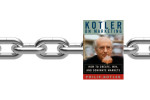Creating Disruption

Create Marketplace Disruption: How to Stay Ahead of the Competition by Adam Hartung
Creating disruption is a highly sought after capability due to the promise of profit and longevity through innovation and growth. Multiple disruptions over time can extend corporate success beyond market cycles.
Many books seek to crack the code of repeat innovation and capitalizing on market shifts. Adam Hartung‘s prescription to the problem is to break what he calls “lock in”, deeply entrenched business practices that tie a business to past success and predictable outcomes. In Create Marketplace Disruption, Hartung zeroes in on the “defend and extend” strategy that many companies use to protect their core business. Hartung finds set of root causes, consequences, and remedies to this situation that are similar to Clayton Christensen’s Innovator’s Dilemma.
Lock Ins combine to create a “Success Formula”, the corporate DNA that institutionalizes successful business practices, but prevents new approaches from being taken. By systematically challenging and breaking “lock in”, a company can enact a new success formula and effectively disrupt itself. Hartung prescribes a set of goals and perspectives that include creating “white space” that eventually incubates a new Success Formula.
Each of these concepts plays out within a business lifecycle, the famous “S” curve. The ideal implementation of this model is “jumping the curve” in which a new line of business or product is introduced just as a previous revenue stream is maturing. Few companies can achieve this goal and Hartung’s book identifies what he believes are the root causes for this.
Hartung’s business lifecycle begins with Infancy (“Wellspring”), then moves through Adolescence (“Rapids”), Maturity (“Flats”), Decline (“Swamp”), Old Age (“Whirlpool”). The critical point on this curve is the “reinvention gap” between the Rapids and the Flats where businesses must create disruptive initiatives to overcome the eventual decline of current products and services. He notes that 3 out of 4 companies experience negative growth after reaching a stall point.
Hartung adds disruption to the common definition of business success which includes hard work, diligence, tenacity, goal setting, planning, and execution.
People don’t like to undertake Disruptions, but they are not nearly as painful as feared. Disruptions are like vaccinations.
Creative Disruption
Business education is steeped in optimizing execution as opposed to managing innovation.
This book offers a diagnosis of why managers, when faced with market discontinuities and competitive threats, double-down on current practices and, in doing so, hasten their own demise. By focusing on the core and avoiding damages to existing business models, corporate leaders blind themselves to new opportunities and future growth potential. This mindset is opposed to the concept of creative disruption, introduced by Joseph Schumpeter, which describes the damage innovation can unleash on the status quo.
Defend & Extend
At its core Defend & Extend Management overlooks the reality that organizations compete in dynamic markets. Defend & Extend produces Success Formula enhancement only as long as the environment does not change. D&E relies on static markets.
Hartung identifies the root cause of failures to innovate and survive as the “defend and extend” approach. This is a similar principle as Clayton Christensen’s “innovator’s dilemma” in which a company is naturally attracted to retaining its core, high profit business and cedes lower profit market segments to disruptive newcomers.
The Success Formula
For most people and organizations, success is not about achieving goals. Success is defending and extending each day, each week, and each month what was done in the past.
The Success Formula is essentially the business model and internal processes that have gotten the company where it is today. A company is successful because it has found a winning formula for earning profit in the marketplace.
Success Formulas are comprised of Identities, Strategies, and Tactics. Identities (“who are we?“) are the foundation of Success Formulas and, although often unspoken, can serve to constrain innovative thinking by limiting the domains in which a company engages. These deep definitions (“we’re in the hardware business“, “we sell software“) cascade to the Strategies and Tactics that make up the daily operations of a business.
Lock-In
Because D&E Management is Locked-in, success becomes operating the Success Formula rather than producing results. Managers aren’t measured on market results, but rather how well they operate inside Lock in, supporting the old Success Formula.
If the Success Formula is the villian in Hartung’s book, then Lock-Ins are its henchmen. Success Formulas cannot be changed directly; rather, they must be deliberately dismantled one Lock In at a time. Lock Ins are specific business model elements, metrics, incentives, rewards, behaviors, and operating practices that serve to collectively reinforce and perpetuate the Success Formula. The first step in removing Lock In is to identify biases and processes which support the core business.
Attacking a competitors’ Lock In is also a key strategy as it exposes potential weaknesses in their Success Formula and can give insight into new approaches and market opportunities. Being tuned into competitors’ Lock In gives businesses better sensitivity to their own assumptions and constraints.
The Phoenix Principle
All success formulas hit the Flats so all need to be evolved. The Phoenix Principle must become a way of life.
Phoenix Principle companies are not afraid to fail.
The Phoenix Principle is Hartung’s code for the continual process of relentlessly destroying Lock Ins and creating new White Space initiatives to move the company forward via disruptions. Hartung gives many examples of companies who spread their bets by investigating alternate products and services as White Space initiatives. He defines a Phoenix Principle company as one that is “in the business of addressing market challenges by migrating toward customer demand and building Success Formulas that produce above average returns.”
White Space
This is where new Success Formulas are born. White Space is a disruptive opportunity involving new products and new customers–much like the new markets/new products quadrant of the Ansoff Matrix. Hartung notes that White Space is not a “skunk works” project, rather it’s a highly visible project that is acknowledged to be the kernel of the company’s new business approach. White Space not only creates the future, its job is also to provide a bridge backwards to existing products/services and sales/marketing strategies. For White Space to be successful, it’s important that the team is given explicit permission to violate current Lock Ins. Otherwise, managers spend more time engaging in battles with Lock Ins than they do getting the new product or service out into the market. White Space teams need to be adequately resourced, highly accountable, and remain separate from the core business. Hartung points out that many times a White Space project is sold off to gain financial resources for fueling the core business (defend & extend strategy).
Success, Hartung says, is about “keeping the Success Formula evergreen”, rather than defending and extending it until it completely loses steam. The strategies listed in the book are meant to support the continual reinvention that increases survival rates for innovative companies. Hartung is careful to point out disruptions cannot be planned, rather they must be identified through a process of attacking Lock In and providing White Space for multiple new initiatives. “Change comes from..altering Lock Ins” in behavior and structure.
In the video below, Hartung discusses why the Defend & Extend approach doesn’t work in a global environment of rapid market shifts. He says one of the key differences between companies whose growth stalls and those whose growth doesn’t stall is how they approach planning. The winning approach is to look forward with scenario planning rather than looking at past performance through the rear view mirror. Hartung also emphasizes not asking your customers to plan for you and paying attention to competitors who are on the fringe. “Strategic customers” typically are large ones that are well served by existing Success Formulas so they are unlikely to be signposts for the future. Finally, success requires comfort with internal disruption and providing White Space for those disruptive efforts.
More on Creative Disruption







